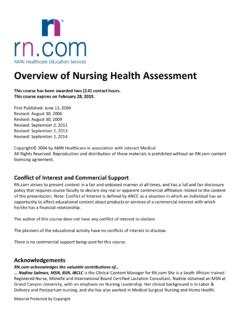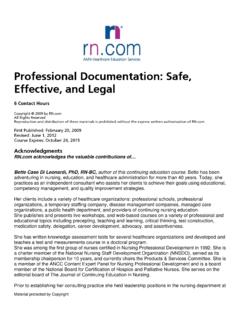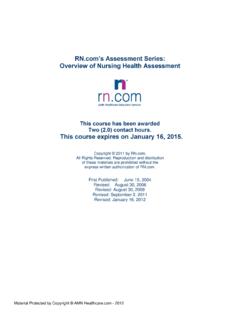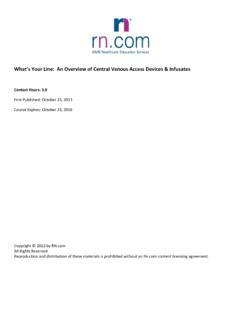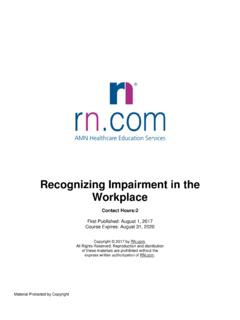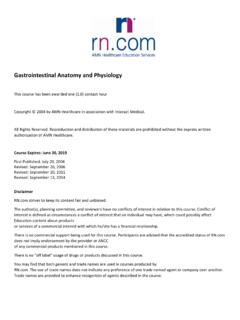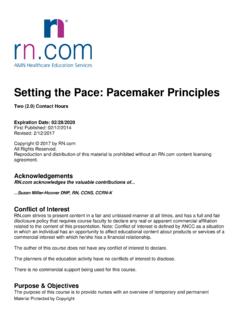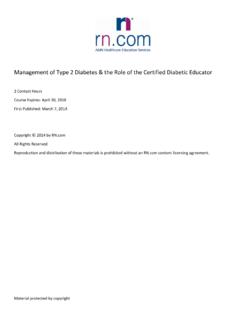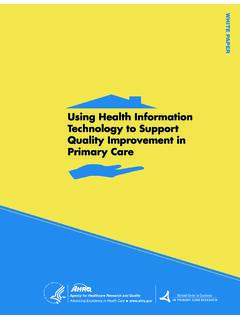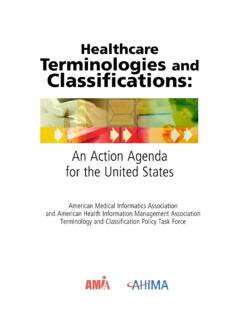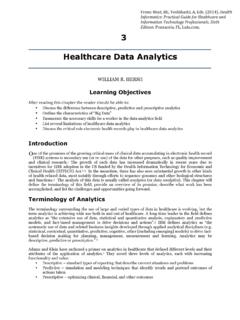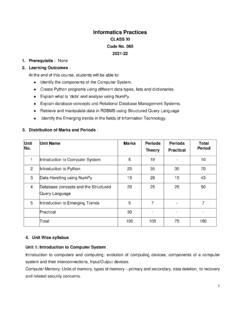Transcription of Nursing Informatics - RN.com
1 Material protected by copyright Nursing Informatics The Future is Here One (1) Contact Hour First Published: April 1, 2013 Course Expires: September 30, 2016 Reproduction and distribution of these materials is prohibited without the express written authorization of Copyright 2013 by All Rights Reserved Acknowledgments acknowledges the valuable contributions Kim Maryniak, RNC-NIC, BN, MSN has over 23 years staff nurse and charge nurse experience with medical/surgical, psychiatry, pediatrics, and neonatal intensive care. She has been an educator, instructor, and Nursing director. Her instructor experience includes med/surg Nursing , mental health, and physical assessment. Kim graduated with a Nursing diploma from Foothills Hospital School of Nursing in Calgary, Alberta in 1989.
2 She achieved her Bachelor in Nursing through Athabasca University, Alberta in 2000, and her Master of Science in Nursing through University of Phoenix in 2005. Kim is certified in Neonatal Intensive Care Nursing and is currently pursuing her PhD in Nursing . She is active in the National Association of Neonatal Nurses and American Nurses Association. Kim s current and previous roles in professional development included Nursing peer review and advancement, education, use of simulation, quality, and process improvement. Her current role includes oversight of professional development, infection control, patient throughput, and Nursing operations. Material protected by copyright Purpose The purpose of this course is to provide nurses with an overview and basic understanding of how Informatics and information technology can be used to improve the delivery of quality patient care.
3 Learning Objectives After successful completion of this course, you will be able to: Define Nursing Informatics . Discuss implementation of technology in healthcare. Discuss ways in which nurses can participate in the implementation of new technology. Describe the roles and responsibilities involved in Nursing Informatics . Describe the specialty of Nursing Informatics and explain educational pathways to certification. Introduction Technology has increased rapidly over the past four decades, and has become an integral part of healthcare. Nurses have participated in the purchase, design, and implementation of information technology in healthcare. The knowledge required for the field of Nursing Informatics has expanded and it is now a recognized specialty in the profession.
4 Nursing Informatics is considered both a science and a system, including process and data. Definition of Nursing Informatics The term Nursing Informatics was initially seen in literature in the 1980s, including a definition of combining Nursing , information, and computer sciences for managing and processing data into knowledge for using in Nursing practice (Murphy, 2010). In 1994, The American Nurses Association (ANA) began developing a statement to describe and define the scope of Nursing Informatics (Baker, 2012). The meaning of Nursing Informatics has evolved and been refined, with the American Nurses Association (2008) definition stated as a specialty that integrates Nursing science, computer science, and information science to manage and communicate data, information, knowledge, and wisdom in Nursing practice (p.)
5 65). Another definition of Nursing Informatics comes from the American Medical Informatics Association (AMIA), which states Nursing Informatics science and practice integrates Nursing , its information and knowledge and their management, with information and communication technologies to promote the health of people, families and communities worldwide (2009, para. 1). Components of Nursing Informatics It was identified by the Institute of Medicine (IOM) report in 2001 that a transformation in healthcare is needed. Included in this report was a call for the use of health information technology (IT) to enhance the quality, safety, and efficiency of healthcare. This transformation includes improving communication between providers and patients, automating clinical information, reducing errors, and promoting evidence-based practice.
6 Nursing Informatics (NI) supports the decision-making of patients, nurses, and other providers in all roles and settings. This assistance is achieved through the use of information structures, processes, and technology. Informatics nurses are those who have extensive clinical practice, are considered experts in using the Nursing process, and have additional experience and education with technology (Healthcare Information and Management Systems Society [HIMSS], 2012). Material protected by copyright Test Yourself: Which of the following is NOT considered part of the definition of Nursing Informatics ? a) Information science b) Social science c) Computer science d) Nursing science Theory with Nursing Informatics Theories in Nursing include concepts and relationships that assist in providing framework.
7 Theories that assist in defining Nursing Informatics include systems theory, cognitive theory, and change theory. Systems theory: Systems theory looks at interacting parts within boundaries, and can be seen with the use of technology and the body systems of patients. Cognitive theory: Cognitive theory can be related to input, output, and processing. Change theory: Change theory is applied in looking at the dynamic processes that are incorporated with Nursing Informatics . (Baker, 2012) Meaningful Use The Patient Protection and Affordable Care Act and the American Recovery and Reinvestment Act of 2009 (ARRA), includes incentive payments from the Centers Medicare and Medicaid Services (CMS) to eligible hospitals and providers for the meaningful use of certified health information technology products.
8 Meaningful use is mandated for providers and hospitals to improve quality, safety, communication, and coordination in healthcare. There are three components of meaningful use: use of an electronic health record (EHR) in a meaningful manner, use of EHR technology for electronic exchange of information, and use of EHR technology to submit clinical quality measures (CMS, 2010). Stage one of meaningful use for hospitals includes reporting of 14 core objectives and 15 clinical quality measures, and stage two includes 16 core objectives and 6 hospital menu objectives (CMS, 2010 and 2012). Meaningful Use Hospital Menu Objectives Stage 1 Drug-formulary checks Record advanced directives for patients 65 years or older Incorporate clinical lab test results as structured data Generate lists of patients by specific conditions Use certified EHR technology to identify patient-specific education resources and provide to patient.
9 If appropriate Medication reconciliation Summary of care record for each transition of care/referrals Capability to submit electronic data to immunization registries/systems* Capability to provide electronic submission of reportable lab results to public health agencies* Capability to provide electronic syndromic surveillance data to public health agencies* * At least 1 public health objective must be selected Material protected by copyright Meaningful Use Core Objectives Stage 1 Computerized provider order entry (CPOE) Drug-drug and drug-allergy interaction checks Record demographics Implement one clinical decision support rule Maintain up-to-date problem list of current and active diagnoses Maintain active medication list Maintain active medication allergy list Record and chart changes in vital signs Record smoking status for patients 13 years or older Report hospital clinical quality measures to CMS or States Provide patients with an electronic copy of their health information, upon request Provide patients with an electronic copy of their discharge instructions at time of discharge.
10 Upon request Capability to exchange key clinical information among providers of care and patient-authorized entities electronically Protect electronic health information (CMS, 2010) Components of meaningful use through the EHR include computerized physician order entry, patient demographics, vital signs, medication reconciliation, drug interactions, allergies, smoking status, clinical decision support, interdisciplinary communications, advance directives, confidentiality, transitions of care, patient education, and ability of patients to obtain a copy of their EHR (CMS, 2010 and 2012). As the criteria of meaningful use evolve, it is essential that nurses be involved as key stakeholders in the planning, design, implementation, evaluation, and optimization of health IT (HIMSS, 2011).
